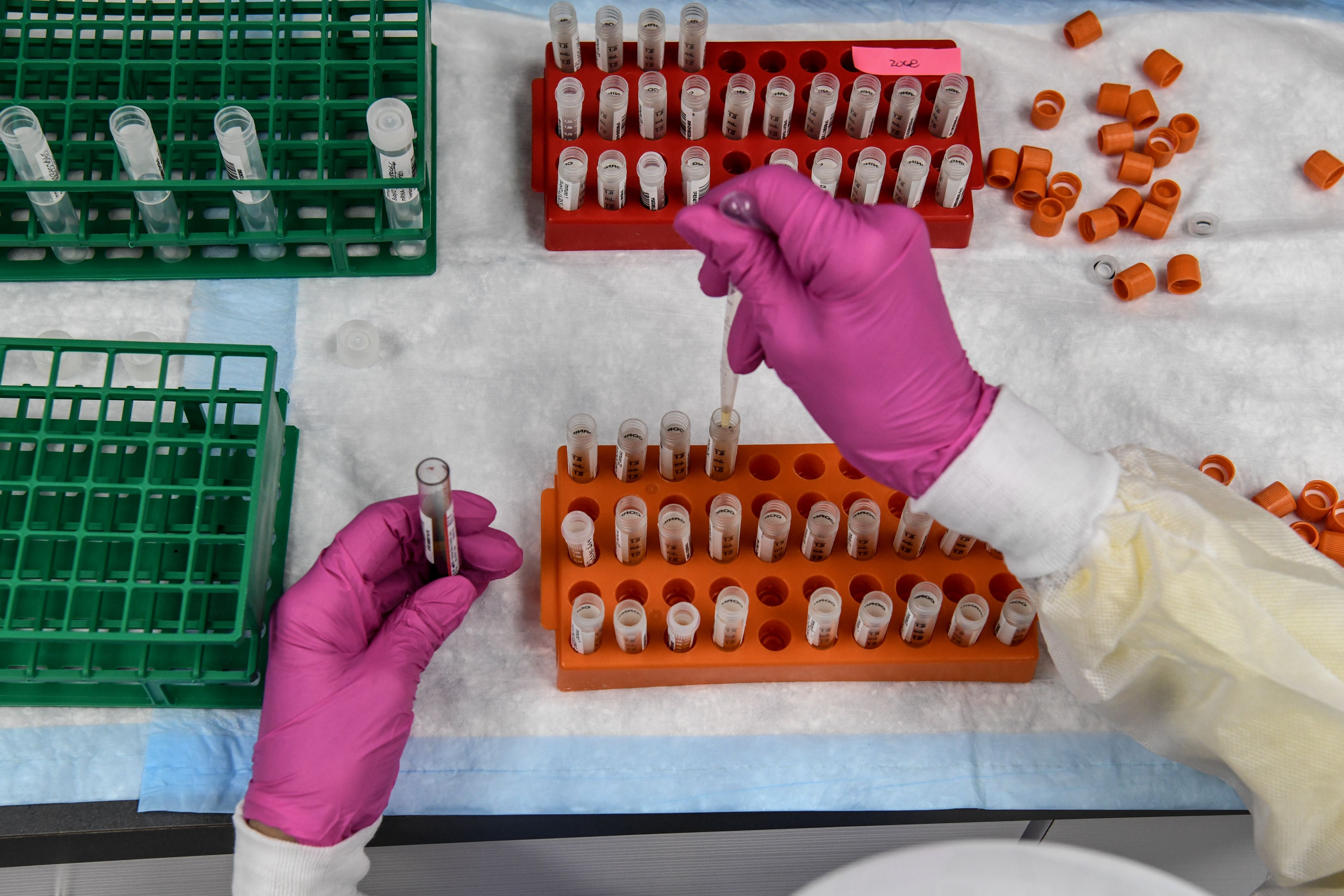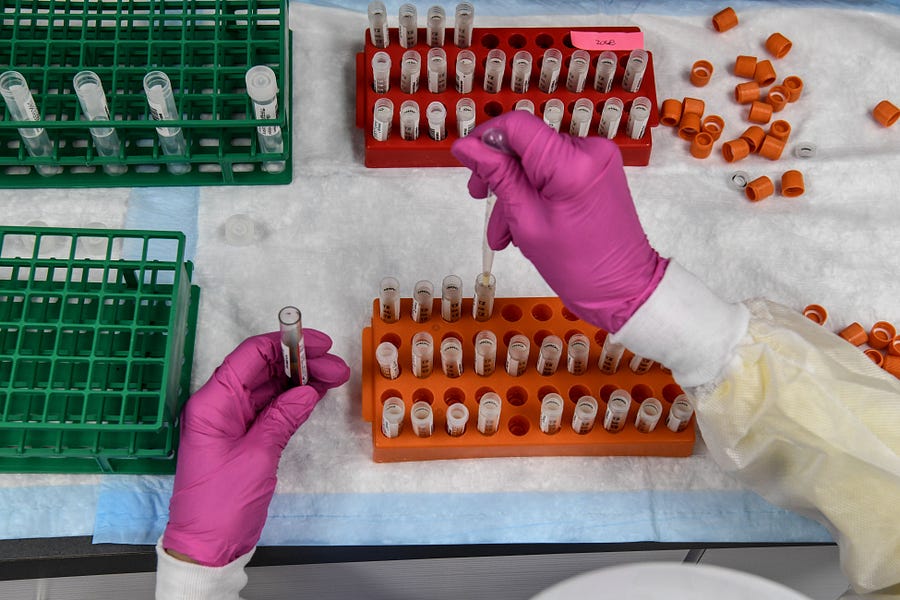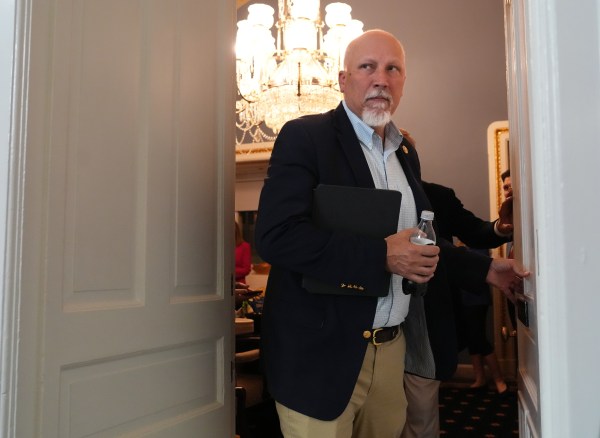Happy Monday! Three weeks from today, with the election behind us (we hope!), The Dispatch will host a two-day conference to examine the elections and their meaning. Some of the country’s top thinkers will be on hand to discuss what’s happened and what’s to come—in the nation’s capital, on the center-right, and for the country. Head over to WhatsNextEvent.com for details and stay tuned—we’ll be announcing additional speakers over the next three weeks.
Quick Hits: Today’s Top Stories
-
The United States confirmed 49,951 new cases of COVID-19 yesterday per the Johns Hopkins University COVID-19 Dashboard, with 5.2 percent of the 962,806 tests reported coming back positive. An additional 512 deaths were attributed to the virus on Sunday, bringing the pandemic’s American death toll to 219,669.


-
Thousands attended demonstrations in France over the weekend in solidarity with Samuel Paty, a schoolteacher who was beheaded in the street by an apparent Islamic extremist on Friday.* During a lesson for his students on freedom of expression, Paty had displayed caricatures of the prophet Muhammed from Charlie Hebdo, the satirical magazine whose Paris headquarters was attacked in 2015.
-
Pfizer CEO Dr. Albert Bourla announced on Friday the pharmaceutical giant will not apply for emergency authorization of its COVID-19 vaccine until the third week of November at the earliest. “Safety is, and will remain, our number one priority,” he wrote.
-
Joe Biden was asked about last week’s New York Post story for the first time over the weekend. He said “I have no response,” dismissed it as “another smear campaign,” and attacked the CBS News reporter who asked him.
-
The Treasury Department announced Friday that the U.S. budget deficit reached a record $3.1 trillion during fiscal year 2020, due in large part to federal coronavirus relief measures.
-
Fighting between Armenia and Azerbaijan reignited minutes after a Russian-brokered truce took effect Saturday night. Both sides have accused the other of violating the ceasefire.
-
The Trump administration approved wildfire disaster relief for California Friday hours after initially announcing it would reject Gov. Gavin Newsom’s request.
-
New Zealand Prime Minister Jacinda Ardern won a second term over the weekend, with her Labour Party having its best election in decades.
Emergency Authorization for Pfizer’s Vaccine Pushed Back

Pfizer announced last week that the pharmaceutical company will not seek FDA emergency authorization for its COVID-19 vaccine until at least the third week in November. The news coincided with a nationwide surge in the virus, with newly reported cases surpassing 70,000 on Friday for the first time since July.
Although Pfizer may know whether the vaccine is effective by the end of October, government safety protocols stand in the way of immediate emergency authorization from the FDA. “A key point that I’d like to make clear is that effectiveness would satisfy only one of the three requirements and, alone, would not be enough for us to apply for approval for public use,” Pfizer CEO Dr. Albert Bourla said in the company’s statement. “In the instance of Emergency Use Authorization in the U.S. for a potential COVID-19 vaccine, FDA is requiring that companies provide two months of safety data on half of the trial participants following the final dose of the vaccine.”
Pfizer’s timeline accords with CDC Director Robert Redfield’s mid-September projection that a vaccine would likely not be approved until the first or second quarter of 2021. Moderna, AstraZeneca, and Johnson & Johnson are also currently enrolled in late-stage clinical trials for a COVID-19 vaccine, although the trials for AstraZeneca and Johnson & Johnson have been suspended in the United States over safety concerns.
Applying for FDA emergency authorization is a thorny process. “Even if you get companies filing applications at the end of November,” Pfizer board member and former FDA Commissioner Dr. Scott Gottlieb explained on Sunday, “it’ll take the FDA two to four weeks to turn that application around.” He told CBS’s “Face the Nation” that after the filing process, “it will take us another two to four weeks to get the initial tranche of people, the most vulnerable who are indicated for the vaccine, vaccinated.”
Gottlieb said that this prioritized group will then receive a second dose of the vaccine over the span of three to four weeks, after which it will likely take another two weeks for viral immunity to kick in. “So you’re looking at a situation where the first tranche of people to get vaccinated really won’t be protected from the vaccine probably till February and maybe March,” he said. The Trump administration announced on Friday its partnership with Walgreens and CVS to administer free, on-site vaccines to senior residents in long-term care facilities, a move that would speed up the distribution process once a vaccine is approved.
In the meantime, however, experts are warning that the pandemic will only grow more painful as cases and hospitalizations shoot back up. “The next six to 12 weeks are going to be the darkest of the entire pandemic,” University of Minnesota epidemiologist Michael Osterholm said on Meet the Press Sunday. “This virus is going to keep looking for wood to burn for as long as it can.”
Gottlieb, who played a substantial role in helping the White House develop its comparatively active pandemic response in the late spring, said this problem has been compounded by a vacuum of leadership as the pandemic has stretched on.
“If you look at the White House strategy, they’ve come out against universal masking. They’ve come out against testing asymptomatic and mildly symptomatic people,” Gottlieb said. “So it begs the question, what is the strategy? And I think the strategy is just to endure the spread until we get to that vaccine. … And it’s probably likely to be the biggest wave that we endure without the benefit of a vaccinated population.”
Even when a vaccine does arrive, it will likely be met with some skepticism. Per Gallup, Americans’ willingness to receive an FDA-approved coronavirus vaccine dropped from 66 percent in July to 50 percent in late September. “The amplified political rhetoric around vaccine development, timing and political credit is undercutting public confidence,” Dr. Bourla wrote in a letter to Pfizer employees earlier this month, although he maintained that the company “would never succumb to political pressure” regarding the vaccine’s timeline.
Neither presidential campaign has a monopoly on politicizing this process. President Trump accused the “deep state” at the FDA of “hoping to delay” a vaccine until after the election, referring to the agency’s safety precautions as “just another political hit job.”
Sen. Kamala Harris has sown doubt about any vaccine that is approved by the Trump administration before the election. “I will not take [Trump’s] word for it,” Harris said back in early September of a COVID-19 vaccine approved before the election. She predicted that public health experts will be “muzzled,” “suppressed,” and “sidelined”.
She walked back that position slightly in the vice presidential debate. “If the public health professionals, if Dr. Fauci, if the doctors tell us that we should take it, I will be the first in line to take it, absolutely,” she said, though she reiterated that “if Donald Trump tells us that we should take it, I’m not taking it.” In his ABC News town hall last week, Joe Biden said he’d take—and encourage others to take—a vaccine that’s “been tested and … gone through the three phases.”
Even after a vaccine is approved—and distributed—mask-wearing, social distancing, and testing will continue to remain part of our efforts to prevent the spread of the coronavirus. “I might even go so far as to say that this face mask is more guaranteed to protect me against COVID than when I take a COVID vaccine,” CDC Director Robert Redfield said during a Senate Appropriations subcommittee hearing in September. “Because the immunogenicity may be 70 percent, and if I don’t get an immune response, the vaccine’s not going to protect me. This face mask will.”

A Surge in Early Voting
You’ll probably hear someone mention today that we’re only two weeks out from the election. And while it is true that November 3 is exactly 15 days from today, the election itself is well underway. According to University of Florida political scientist Michael McDonald, 28,117,692 Americans have already voted in the 2020 election. That’s 20.6 percent of the total 2016 vote—and we’re still two weeks away!
“In 2016 at this point after the first week of early voting, there had been only 64,000 ballots cast,” Ohio Secretary of State Frank LaRose told The Dispatch last week. “This year, [it’s] close to 200,000.”
And Ohio is not alone. Kansas Deputy Assistant Secretary of State Katie Koupal told us at the end of September that the state had processed 384,387 advance by-mail ballot applications for the general election (51,455 were sent out in the 2016 primary). Maine Secretary of State Matthew Dunlap said the Pine Tree State saw about a six-fold increase in absentee ballots sent out from the 2018 primary to the 2020 primary. “The turnout was much higher than we predicted,” he said. “I think that part of that could be attributed to the fact that here we are, having this public discussion about how do you run an election, right? And it kind of got people’s attention: They realize, ‘Hey, there’s an election!’”
There’s no doubt that some voters are simply shifting their voting timelines up a few weeks due to the pandemic; several states have expanded early voting opportunities this year as a way to reduce crowding in the age of coronavirus.
But elections experts see something else going on. “Every indicator—including early voting—points to record-shattering turnout in this election,” Cook Political Report elections analyst Dave Wasserman told The Dispatch. “We’re likely to see between 150 million and 160 million votes cast, which is way up from the 137 million in 2016. We are essentially looking at a record turnout among eligible voters since women earned the right to vote.”
The election is the biggest story in the country, and many have tried to parse these early data for hints about how our government could look come January. “59% of first-time voters who already cast ballots in Pennsylvania are registered Democrats,” a recent Axios piece reads, “compared to the just 15% who are registered Republicans. Democratic first-time voters were just barely outvoting Republicans (40% to 38%) at this point in 2016.”
But some experts advise against reading these tea leaves. “There will be a massive difference between the percentage of Biden and Trump supporters who will vote early,” CNN’s Harry Enten wrote over the weekend, noting that Biden supporters are far more likely to cast early ballots. “The issue is that we really don’t know the extent to which the early vote will be more Democratic-leaning than the overall tally. There’s no history of early voting during a pandemic. Moreover, just because we know the party affiliation of the voters returning ballots in some states doesn’t mean we know [who] they’re voting for.”
Wasserman concurred. “It’s extremely dangerous to be basing election predictions on early voting statistics, and those who do it are guilty of a cardinal sin in my book.”
“I also see a lot of statistics flying around about how one out of every five early voters or whatever has not voted before,” Wasserman continued. “Well, it’s possible that one out of every five total voters this election will not have voted before. We can’t be sure who that helps or hurts.”
Democrats tend to believe that high turnout plays to their advantage. “Democrats win when the voter turnout is high,” Sen. Bernie Sanders said in 2016. “Republicans win when the voter turnout is low.” Many Republicans—including the president—seem to buy into this framing. “They had things—levels of voting that, if you ever agreed to it, you’d never have a Republican elected in this country again,” President Trump said in March of Democrats’ efforts to include money for absentee and vote-by-mail in the first major stimulus package.
But the reality is not so clear-cut. “Higher turnout benefits different candidates in different states,” Wasserman said. “The bulk of non-voters in Wisconsin in 2016 were whites without college degrees. The overwhelming percentage of non-voters in Pennsylvania and Michigan, same thing. But the overwhelming number of eligible non-voters in Texas and Arizona were non-white and young voters. So I do believe that there is upside beyond what the polling shows for Democrats in the Sun Belt, and that there’s upside beyond [what] polling shows for Republicans in the Rust Belt.”
Worth Your Time
-
In the Sunday New York Times, Ross Douthat tells progressives concerned about right-wing populism that they could be the real authoritarian threat. “Pressure from the heights of big media, big tech and the education system” could, Douthat says, enable progressives to impose their will on American culture and society, even if conservatives stay electorally competitive. As control of newspapers, the internet, and academia becomes consolidated under powerful institutions like the Times, Facebook, and Harvard—a younger generation of elites is becoming radicalized, “embracing a new progressive orthodoxy that’s hard to distill but easy to recognize and that really is deployed to threaten careers when the unconvinced step out of line.” Though some conservatives may exaggerate it, the threat this change poses is very real. Power “lies in many places in America, but it lies deeply, maybe ineradicably for the time being, in culture-shaping and opinion-forming institutions that conservatives have little hope of bringing under their control.”
-
“There’s no more school. There’s no more church. No more friends. We gave it all up for squash,” complains one mother in sports-mad Darien, Connecticut. Ruth S. Barrett, writing in The Atlantic, has a fascinating profile on the American upper classes’ obsession with niche sports. Buoyed by a striver’s mentality, an obsession with elite universities, and the desire to overcome “the penalty that comes from being from an advantaged zip code” in college admissions (as one parent put it), wealthy parents are pushing their children into less-popular sports like fencing and squash. The reason? It’s much easier to get recruited to the Yale fencing team than its basketball squad, or as (gasp!) a non-athlete. The result is a never ending cycle of private coaches, travel teams, and personal trainers for children as young as ten or twelve, and a situation that seems straight out of a Christopher Guest movie.
-
National Review’s Jon Loftus sat down with heterodox liberal demographer Joel Kotkin to discuss if the GOP can hope to ever win over millennial voters. Kotkin says that with Trump at the helm the Republican Party “can’t talk to millennials, can’t talk to a lot of women, can’t talk to minorities, and can’t talk to immigrants.” But there’s hope, Kotkin says, if the GOP manages to shed the Trump brand. A focus on upward mobility and property ownership will be crucial in order to appeal to a generation that struggles to settle into the single-family home lifestyle that continues to appeal to most Americans.
Presented Without Comment
Toeing the Company Line
-
In the latest Dispatch Podcast, Sarah and David were joined by Renée DiResta of the Stanford Internet Observatory to discuss online disinformation and journalistic ethics. “Anybody with a laptop can make themselves look like a media organization,” she warns. They “can use a variety of social media marketing techniques to grow an audience, and then can push out whatever they want to say to that audience.”
-
David often hears from young Christians, “I’m pro-life, I believe in religious freedom and free speech, I think we should welcome immigrants and refugees, and I desperately want racial reconciliation. Where do I fit in?” His answer: Nowhere. In his Sunday French Press this week, David argues that this political homelessness can be a blessing—if you embrace it. “Your commitment to Christ is permanent, eternal,” he writes. “Your commitment to a party or a politician is transient, ephemeral.”
-
Empathy is a virtue, but in his Friday G-File Jonah warns that it’s one politicians can often use for evil: “The antonym of empathy is antipathy, but in the political context they are not simply opposites. One goes hand in hand with the other. Politicians and culture warriors use empathy to arouse antipathy.” You can find more thoughts on originalism, and other important points of clarification, in Friday’s Ruminant.
Let Us Know
Very shortly, America will witness a battle for the ages. One side has been in the game for what seems like forever, the other is a relative newcomer. One’s base is predominantly on the West Coast, the other’s is mostly in the South. The cash disparity between the respective teams is enormous.
Our question for you: Are you rooting for the Tampa Bay Rays or the Los Angeles Dodgers in the World Series?
Reporting by Declan Garvey (@declanpgarvey), Andrew Egger (@EggerDC), Charlotte Lawson (@charlotteUVA), Audrey Fahlberg (@FahlOutBerg), James P. Sutton (@jamespsuttonsf), and Steve Hayes (@stephenfhayes).
Photograph by Chandan Khanna/AFP via Getty Images.
Correction, October 19, 2020: An earlier version of this newsletter misspelled Samuel Paty’s name.







Please note that we at The Dispatch hold ourselves, our work, and our commenters to a higher standard than other places on the internet. We welcome comments that foster genuine debate or discussion—including comments critical of us or our work—but responses that include ad hominem attacks on fellow Dispatch members or are intended to stoke fear and anger may be moderated.
With your membership, you only have the ability to comment on The Morning Dispatch articles. Consider upgrading to join the conversation everywhere.